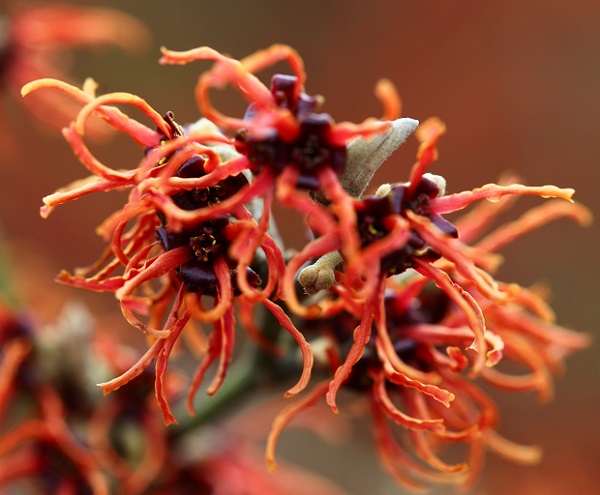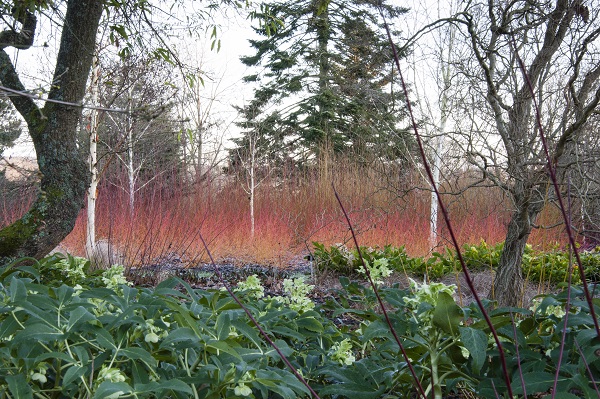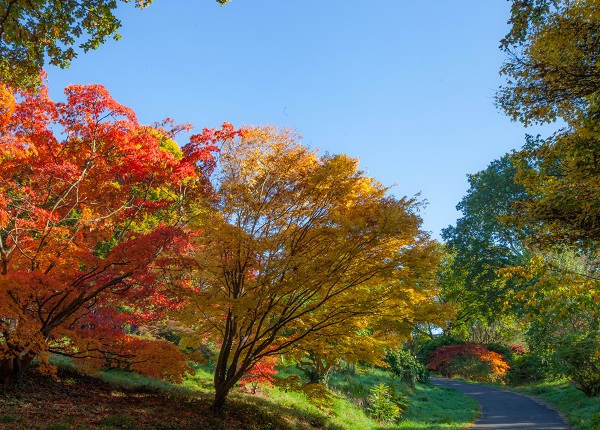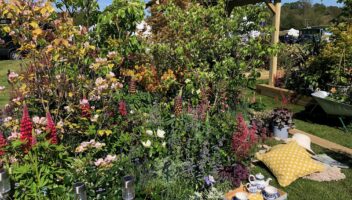The striking combination of Ophiopogon planiscapus ‘Nigrescens’ and Rubus cockburnianus at the world famous Winter Garden at Sir Harold Hillier Gardens. Photo credit: Matt Pringle for Sir Harold Hillier Gardens
For many, winter is the season where we forget about the garden – we tidy it in the autumn and put it to bed until spring – but it needn’t be so. A well-planned winter garden can be just as striking as your spring and summer show, raising the spirits even when the weather doesn’t.
Winter Interest from Flower, Leaf and Stem
Winter-flowering plants are less abundant than those that bloom in the summer, but they offer a lot. Exquisite colour and form are often complemented by amazing scent – an evolutionary race to attract the sparse pollinators at this time of year.
 The rich red flowers of Hamamelis x intermedia ‘Rubin’
The rich red flowers of Hamamelis x intermedia ‘Rubin’
Hamamelis, or Witch Hazel, are medium to large shrubs or small trees with delicate and spiderlike flowers in fiery tones of red, orange or yellow. Borne on bare branches after the attractive autumn foliage has fallen, the flowers are highly fragranced. Underplant with hellebores whose glossy green foliage sets-off beautiful single or double blooms. The H. niger and H. x ericsmithii varieties flower before Christmas and are usually white, while H. orientalis types flower later but offer different shades – reds, pinks, purples, yellows and even slate grey. Other great options for underplanting include hardy cyclamen, winter aconites and of course snowdrops – Galanthus nivalis is the common snowdrop but there are many varieties to choose from.
 Helleborus x ballardiae HGC ‘Snow Dance’ produces beautiful large flowers from winter into spring
Helleborus x ballardiae HGC ‘Snow Dance’ produces beautiful large flowers from winter into spring
A fine stand-alone shrub, Mahonia japonica has leathery, spine-toothed, evergreen leaves which often colour up in autumn and winter as the plant flowers. The flowers are usually yellow, some varieties orange, and are held in clustered racemes above rosettes of foliage. As a bonus, small purple fruit follow, extending the season of interest.
Mahonia japonica, an excellent shrub choice for winter interest
For a smaller space, or to clip into a low hedge, Sarcococca confusa, or Christmas box, is a fine choice. The glossy evergreen foliage stays mid-green all year round and the stems are graced by masses of tiny white fragrant flowers in December. Plant near a path to get the benefit of the glorious scent.
The tiny fragrant flowers of Sarcococca confusa, aptly known as Christmas box
If you are planting against a wall or trellis, try tying Chaenomeles (or ornamental quince) for masses of flower power or Jasmine nudiflorum (winter jasmine) for a reminder of the golden sunshine of summer.
For stem colour it is hard to beat the dogwoods. Varieties of Cornus alba, C. sericea and C. sanguinea have bright winter stems in shades from yellow, lime-green, orange and red to purple-black. Plant in groups of three or five for massed stem effect and cut back to 6 to 12 inches from the ground each spring to ensure the brightest stem colour the following winter.
Creating Striking Winter Plant Contrasts
In the world-famous Winter Garden at the Sir Harold Hillier Gardens in Romsey, one of the most striking plant pairings is the bone-white stems of Rubus cockburnianus, or white-stemmed bramble, arching over massed plantings of Ophiopogon planiscapus ‘Nigrescens’.
If you prefer more colour in your garden, pair the orange stems of Cornus sanguinea ‘Midwinter Fire’ with low evergreens such as Euonymus fortunei varieties or evergreen ferns. Summer grasses such as molinia, panicum and pennisetum often hold their seed heads long into the winter and contrast well with evergreen plants such as Viburnum tinus in bud and flower at this time of year.
 Betula albosinensis ‘Fascination’ together with Cornus sanguinea ‘Winter Beauty’ at Sir Harold Hillier Gardens. Photo credit: Rachel Chappell for Sir Harold Hillier Gardens
Betula albosinensis ‘Fascination’ together with Cornus sanguinea ‘Winter Beauty’ at Sir Harold Hillier Gardens. Photo credit: Rachel Chappell for Sir Harold Hillier Gardens
Plants For Winter and Year-Round Interest
In a sheltered spot, an acer (Japanese maple) is a great winter plant. Many have bright winter stems almost as impressive as cornus. They are hardy in most UK winters once established but may need protection in colder years. Acer ‘Sango-kaku’ has red-orange stems while A. ‘Katsura’ is bright yellow and A. ‘Beni-maiko’ scarlet.
 The outstanding acer valley at Sir Harold Hillier Gardens. Photo credit: Matt Pringle for Sir Harold Hillier Gardens
The outstanding acer valley at Sir Harold Hillier Gardens. Photo credit: Matt Pringle for Sir Harold Hillier Gardens
Skimmia offer year-round evergreen foliage, glossy green and attractive. They set bud in late summer and hold it throughout the autumn before flowering in late winter or early spring with a fragrant, lily-of-the-valley scent. The flower heads are actually made up of hundreds of tiny individual flowers. There are male and female varieties – females such as S. ‘Nymans’ will produce red berries if pollinated by a male such as S. Rubella which tend to have showier flowers. There are also self-fertile varieties such as S. ‘Temptation’ with attractive flowers and berries together on the same plant. Skimmia look great planted alongside the dark winter stems of Cornus alba ‘Kesselringii’ or the bright red of C. alba ‘Sibirica’ and they do benefit from a little shade – too much sun can yellow the leaves.
 Skimmia japonica ‘Rubella’ provides all year round interest, including vibrant red buds in winter
Skimmia japonica ‘Rubella’ provides all year round interest, including vibrant red buds in winter
Finally, one of the best year-round plants for the small garden is Prunus ‘Kojo-no-mai’. Look out for it in the early spring in full flower but plant it at least as much for the autumn foliage colour and the fantastic, architectural twisted stems of winter.





